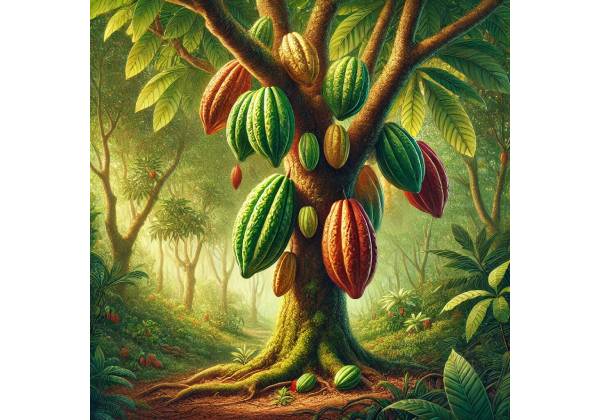Cacao has a reputation that goes far beyond satisfying a sweet tooth. It’s the main ingredient in chocolate, but when you look beneath that decadent surface, you’ll find a complex plant bursting with unique phytonutrients, beneficial compounds, and a long cultural history. This remarkable seed comes from the Theobroma cacao tree—an evergreen typically found in tropical regions near the equator, such as Central and South America and parts of Africa. Known for its distinctive pods packed with seeds (often called “beans”), cacao is cherished for both its flavor and its potential health rewards.
For generations, people have turned to cacao in various forms: sometimes as a ceremonial elixir, sometimes as a fortifying beverage, and sometimes as a sweet indulgence. Contemporary research has begun to reveal the real science behind these traditions, shedding light on why cacao’s active compounds hold so much promise for wellness. Whether you’re intrigued by cacao for its antioxidant capacity, curious about its role in supporting cardiovascular health, or just thrilled by the idea of unprocessed, nutrient-rich chocolate, there’s a world of knowledge waiting to be explored.
Yet, there’s more to cacao than meets the eye. Beneath its fragrant exterior and enticing flavor profiles, you’ll discover a truly fascinating botanical that intertwines with culture, economy, culinary arts, and scientific inquiry. The more you learn about it, the clearer it becomes that cacao offers more than just a delightful treat: it may be a worthwhile addition to a balanced lifestyle.
- Packed with antioxidants that help reduce oxidative stress
- Linked to potential cardiovascular benefits, including improved circulation
- Contains natural mood-enhancing compounds like theobromine
- Offers skin-supportive nutrients and promotes overall wellness
- Features fiber and essential minerals that aid digestion and metabolic health
Table of Contents
- Cacao: A Detailed Botanical Background and Identification Markers
- Cacao: Historical Path and Cultural Impact
- Cacao: Key Phytochemicals and Primary Active Elements
- Cacao: Extensive Health Benefits and Wellness Insights
- Cacao: Fundamental Properties and Distinct Characteristics
- Cacao: Practical Uses, Applications, and Safety Factors
- Cacao: Scientific Evidence and Landmark Studies
- FAQ
Cacao: A Detailed Botanical Background and Identification Markers
When you hear the word “cacao,” it’s easy to think of chocolate bars and sweet desserts. But before cacao becomes part of any confection, it starts as a seed wrapped inside a vibrant pod that grows directly from the trunk and larger branches of the Theobroma cacao tree. This plant thrives in regions near the equator, especially where warm temperatures, consistent rainfall, and humidity abound. Understanding its botanical profile can deepen your appreciation for the complexity that leads to your favorite cocoa-based treats.
Origins and Natural Habitat
The Theobroma genus name means “food of the gods,” and for centuries, cacao has indeed been revered as something special. Though commonly associated with South and Central America—particularly in countries like Ecuador, Peru, and Mexico—cacao also flourishes in parts of West Africa, such as Ivory Coast and Ghana. These areas offer the stable, humid climate and nutrient-rich soils that cacao trees need to produce high-quality pods.
In the wild, cacao trees are understory plants, growing beneath larger canopies. This means they do well in shaded environments, which help regulate temperature and moisture. They’re quite delicate, often requiring attentive care when cultivated on farms or plantations.
Tree Structure and Pod Description
Cacao trees typically reach about 13 to 26 feet (4 to 8 meters) in height, though they can grow taller under ideal conditions. The bark is thin and delicate, and the leaves are large, glossy, and oblong with a deep green hue. One of the most striking features is how the cacao pods grow—directly from the tree trunk or older branches, rather than from the tips of new branches like many other fruits. This phenomenon is referred to as cauliflory.
Each pod can vary in color, shape, and size. Some pods are elongated, while others are rounder. In terms of color, you might see anything from vibrant green, yellow, or orange to deep purple or red, depending on the variety and ripeness. Inside each pod are the cacao seeds or “beans,” nestled within a sweet-sour white pulp.
Bean Characteristics
The beans inside the pod are typically oval-shaped and surrounded by a thick pulp. Fresh cacao pulp has a tangy, citrus-like flavor, often surprising first-time tasters who might expect something chocolatey. The seeds themselves are what eventually become cocoa nibs or cocoa powder after a lengthy fermentation and drying process.
Each cacao bean has layers: a tough outer shell (the husk), a thin membrane known as the testa, and the kernel itself (the nib). The kernel is where the majority of the plant’s beneficial compounds, including theobromine and polyphenols, are concentrated.
Varieties of Cacao
Different varieties exist under the broad umbrella of Theobroma cacao, each with its own flavor profile, chemical composition, and growing requirements. The three main groups are:
- Criollo: Often praised as the “prince” of cacaos for its delicate, nuanced flavor and lower bitterness. It’s rarer and more difficult to cultivate, making it highly valued by artisanal chocolate makers.
- Forastero: Known for its robustness and higher yields, Forastero is the most common commercial variety. It usually has a more straightforward chocolate flavor, but less nuanced than Criollo.
- Trinitario: This is a hybrid of Criollo and Forastero, aiming to combine the hardy nature of Forastero with the finer taste characteristics of Criollo.
These varieties cross-pollinate easily, so you’ll often hear about local hybrids that further expand the range of flavors and compositions.
Identification Tips
If you ever come across a cacao tree in its natural habitat or on a plantation tour, you’ll notice:
- Large, glossy leaves that can measure up to 30 centimeters in length.
- Pods sprouting from the trunk and major branches (cauliflory).
- Colorful pods that range from green to bright yellow, orange, red, or even purple when ripe.
- A thin trunk with bark that can be easily bruised or cut, so farmers must handle it gently.
Another key identifier is the distinctive shape of the pods themselves. They often have ridges running down their sides, making them look somewhat ribbed or bumpy on the exterior. Cutting one open reveals that cluster of roughly 30 to 40 seeds surrounded by the white pulp.
Cultivation and Harvest Seasons
Cacao can produce pods year-round, but there are usually main harvest seasons, with a peak in many regions around mid-to-late year. Trees are most productive in their first few decades, but they can live for more than 50 years with proper care. Cultivation typically involves careful trimming to allow enough sun and airflow, plus a watchful eye for pests or fungal diseases like black pod disease or witches’ broom.
Farms often interplant cacao trees with other crops to provide shade and to maintain biodiversity. It’s common to see banana trees, coconut palms, or taller hardwoods in cacao plantations, which help create a mini-ecosystem that replicates the tree’s natural rainforest environment.
Understanding cacao’s botanical essentials can give you a stronger appreciation for the journey from seed to chocolate bar. Each step—growth, harvest, fermentation, drying, roasting—contributes to the final quality, flavor, and potential health benefits of the cacao you end up enjoying.
Cacao: Historical Path and Cultural Impact
Cacao boasts a vibrant history that spans thousands of years, weaving itself into the cultural and economic fabric of many ancient civilizations. Far from just an ingredient in sweet treats, cacao was once considered a precious commodity—used in rituals, traded as currency, and prized for what ancient peoples believed to be significant healing properties.
Early Origins and Mesoamerican Roots
Archaeological evidence shows that Mesoamerican cultures, including the Olmecs (around 1500–400 BCE), were among the first to cultivate and use cacao. Later, the Mayans and Aztecs followed, refining the art of turning cacao beans into beverages mixed with spices like chili, vanilla, and annatto. These drinks, often bitter and frothy, were reserved for the elites, warriors, or religious ceremonies.
The word “cacao” itself stems from the Mayan “kakaw,” while the term “chocolate” likely has Aztec origins (from “xocolatl,” a phrase loosely translating to “bitter water”). The significance of cacao extended beyond culinary uses; it featured in religious offerings, birth rituals, and marriage ceremonies.
Cacao as Currency
For the Aztecs, cacao beans served as a form of money. Historical texts note that people could purchase goods ranging from food to household items using cacao beans as currency. Because of its relatively high value, cacao cultivation and trade became a cornerstone of the Aztec economy. This status also influenced social hierarchies: those who controlled cacao farms and trade routes held significant power.
European Encounter
When Spanish explorers arrived in the Americas in the 16th century, they encountered cacao in these elaborate cultural contexts. They were introduced to the spiced cacao beverages, which they found somewhat bitter. Over time, Europeans modified these drinks by adding sugar or honey, which transformed the flavor profile drastically. As cacao made its way across the Atlantic, it became a luxury item in Europe, coveted by the aristocracy and upper classes.
By the 17th century, cacao and chocolate houses were all the rage in Europe, fueling further demand and leading to cacao cultivation in various colonies under European control. Unfortunately, the surge in cacao production and trade was often tied to exploitation and forced labor, a dark chapter in its otherwise fascinating story.
Industrial Revolution and Modernization
The Industrial Revolution introduced mechanized processes that changed cacao production. Innovations like the cocoa press in the early 19th century helped separate cocoa butter from cocoa solids, laying the groundwork for modern chocolate bars. Names like Van Houten, Fry, Nestlé, Hershey, and Cadbury became synonymous with chocolate manufacturing, each contributing to the evolution of mass-market chocolate products.
During this era, chocolate shifted from an elite indulgence to a more accessible treat for the general population. Sweet, milk-based chocolates and candy bars soared in popularity, overshadowing traditional preparations of cacao. This widespread appeal also increased global awareness of the regions where cacao was grown, further integrating cacao into international trade and economics.
Cultural Symbolism and Tradition
Despite the commercial explosion of chocolate, cacao has retained its cultural resonance in many parts of the world. In Central and South America, some communities continue the time-honored tradition of preparing cacao drinks the way their ancestors did—unsweetened or lightly sweetened, often spiced with chili. These ceremonies highlight cacao’s historical role as a bridge between the spiritual and physical realms.
In some contemporary circles, there’s been a resurgence of interest in cacao ceremonies that aim to reconnect with ancient practices. While opinions vary on the authenticity of these modern spiritual gatherings, the essence of reverence for cacao remains, reflecting the plant’s long-standing importance to human cultures.
Global Influence and Economic Importance
Cacao continues to shape economies worldwide. Ivory Coast and Ghana are now among the largest producers, with millions of people reliant on cacao farming for their livelihoods. In addition, fair trade and sustainable farming initiatives have gained traction, encouraging ethical sourcing, better wages, and environmental stewardship.
From the vantage point of modern society, cacao has maintained its status as a beloved ingredient, but also as an agriculturally crucial crop. Concerns about climate change, deforestation, and labor practices have put the spotlight on more responsible cacao cultivation. This has spurred movements towards organic farming, regenerative agriculture, and direct trade models that empower farmers.
Cacao’s Enduring Legacy
From ancient Mesoamerican ceremonies to the bustling chocolate markets of Europe and the modern push for ethical sourcing, cacao’s story is an ongoing tapestry of tradition, innovation, and cultural exchange. While its form and preparation have evolved, the plant’s fundamental appeal—its distinct flavor, uplifting aroma, and range of potential health benefits—remains as captivating now as it was thousands of years ago.
Today, cacao stands at the intersection of history, gastronomy, health science, and global trade. When you sip on a cup of artisanal hot chocolate or nibble on a square of dark chocolate, you’re partaking in a rich tapestry that spans cultures and centuries, linking you to a global community of cacao growers, artisans, and enthusiasts who keep the spirit of Theobroma cacao alive.
Cacao: Key Phytochemicals and Primary Active Elements
Cacao isn’t just about taste. Within its beans lie a variety of compounds that scientists believe are responsible for many of its reputed health benefits. From polyphenols to alkaloids, cacao’s chemical complexity underscores why it’s been revered across time and cultures. Let’s dig into the main bioactive components that give cacao its remarkable properties.
Polyphenols: Flavonoids and Beyond
A significant share of cacao’s health-boosting reputation can be traced to its rich polyphenol content, especially flavonoids like catechins, epicatechins, and procyanidins. These compounds are often lauded for their antioxidant properties, which can help neutralize free radicals in the body. Free radicals are unstable molecules that can contribute to cell damage and chronic diseases when they accumulate.
- Flavanols (Catechins and Epicatechins): These are studied extensively for their potential roles in supporting heart health, possibly aiding in blood vessel dilation and circulation.
- Anthocyanins and Procyanidins: Additional flavonoids in cacao might bolster the antioxidant capacity and add subtle astringent qualities to raw cacao products.
Alkaloids: Theobromine and Caffeine
Cacao contains two notable alkaloids—caffeine and theobromine. While both can stimulate the central nervous system, they do so in slightly different ways.
- Caffeine: It’s less concentrated in cacao than in coffee, but it still contributes to mild stimulation, alertness, and sometimes an increase in focus.
- Theobromine: Often considered the signature alkaloid in cacao, theobromine has a milder stimulant effect compared to caffeine. It may help promote a sense of well-being, support cardiovascular function, and even assist with respiratory wellness by dilating airways.
Because theobromine acts more gently than caffeine, many people find cacao to be uplifting without the jittery highs or crashes associated with strong coffee. This unique balance is a major draw for those who want an energy boost without overstimulation.
Minerals: Magnesium, Iron, and More
Cacao is also a source of essential minerals that play diverse roles in overall health. High-quality, minimally processed cacao products often contain:
- Magnesium: Supports muscle and nerve function, helps regulate blood sugar levels, and is vital for energy production and heart health.
- Iron: Important for red blood cell formation and oxygen transport. Cacao, especially in its raw or minimally processed form, can contain notable amounts of iron.
- Potassium: Helps maintain normal blood pressure and fluid balance in the body.
- Calcium: Essential for bones and teeth, although typically less abundant in cacao than in dairy.
These minerals, coupled with cacao’s other nutrients, contribute to a holistic nutritional profile, especially in forms that haven’t been diluted by excessive sugar, dairy, or processing.
Healthy Fats
Cacao beans are roughly 50% fat in their natural state. Cocoa butter (the pale, creamy fat extracted from cacao) is rich in oleic acid (a monounsaturated fat), stearic acid, and palmitic acid. While some saturated fats, like stearic acid, may raise eyebrows, studies indicate that stearic acid from cacao behaves differently in the body than other saturated fats such as those in red meat. In fact, stearic acid appears neutral in its effect on LDL (“bad”) cholesterol levels.
Cocoa butter also gives chocolate its smooth, melt-in-your-mouth texture. Beyond the culinary delight, these fats play a role in how the body absorbs fat-soluble nutrients and antioxidants from cacao.
Fiber Content
Another lesser-known aspect of cacao is its fiber content, particularly in raw cacao nibs or unprocessed cocoa powder. This dietary fiber can help with digestion and may aid in stabilizing blood sugar levels by slowing down the absorption of sugars. Although fiber in chocolate bars is reduced by sweeteners and milk solids, unadulterated cacao products still retain a good fraction of this beneficial component.
Amino Acids and Neurochemicals
Cacao contains trace amounts of specific amino acids and compounds that can influence mood and cognitive function. Phenylethylamine (PEA), often called the “love molecule,” and anandamide, sometimes referred to as the “bliss molecule,” are among these. Though concentrations in typical chocolate may be small, these compounds still intrigue researchers who explore their potential roles in improving mood, cognition, and well-being.
Processing Impact on Phytochemistry
It’s worth noting that the way cacao is processed—from fermentation and roasting to grinding and alkalizing—can significantly affect its final chemical profile. Raw cacao products often have higher levels of certain antioxidants and minerals compared to heavily processed chocolate bars. Alkalized or “Dutch-processed” cocoa powder may have a milder taste but often contains fewer antioxidants than non-alkalized versions.
For those interested in maximizing cacao’s health value, seeking minimally processed forms like raw cacao nibs, cold-pressed cacao butter, or low-heat roasted cocoa powder could be beneficial. However, palatability and personal taste matter too, so finding a balance that fits your preferences and goals is important.
The Synergy of Cacao’s Compounds
Scientists are increasingly recognizing that it’s not just single compounds—like theobromine or epicatechin—that make cacao special. It’s the synergy of all these elements working together. These phytochemicals, minerals, healthy fats, and amino acids could collectively influence everything from circulation to mental clarity.
Ultimately, the complexity of cacao’s chemical makeup is part of its allure. Each compound brings something to the table, and when combined, they create a unique nutritional powerhouse that has fascinated cultures for centuries and continues to captivate researchers today.
Cacao: Extensive Health Benefits and Wellness Insights
Cacao’s allure in ancient times wasn’t just about taste; early civilizations recognized its energy-lifting qualities and believed it possessed healing powers. Modern science has been investigating these beliefs, identifying where the anecdotal wisdom of the past aligns with current research. From supporting heart health to boosting mood, cacao’s potential health benefits are extensive and quite compelling.
Heart and Circulatory Support
One of the most frequently discussed benefits of cacao revolves around cardiovascular well-being. Numerous studies have looked into how flavonoids (particularly epicatechins) in cacao might support heart function. Research published in the American Journal of Clinical Nutrition (2011) linked moderate chocolate consumption to reduced risk factors associated with heart disease.
- Blood Pressure: Flavanols may help arteries relax, potentially contributing to lower blood pressure in some individuals.
- Blood Flow and Circulation: Improved endothelial function can lead to better circulation, which is crucial for overall vascular health.
- Cholesterol Balance: Some studies suggest that cacao’s stearic acid has a neutral effect on LDL (“bad”) cholesterol, while other polyphenols may positively influence HDL (“good”) cholesterol.
Cognitive and Mood-Related Effects
Cacao often comes up in conversations about mood and mental clarity. A warm cup of hot cocoa can indeed feel comforting, but there’s also some science behind this pleasant feeling.
- Neurotransmitter Modulation: Cacao contains small amounts of anandamide, sometimes dubbed the “bliss molecule,” as well as phenylethylamine (PEA). Both substances might influence mood and cognitive performance, although more research is needed on their effectiveness at typical dietary levels.
- Mild Stimulation: The blend of caffeine and theobromine in cacao can provide a gentle energy lift without the pronounced crash often associated with coffee.
- Antioxidant Defenses: Many neurodegenerative issues stem from oxidative stress. The robust antioxidant profile of cacao may offer some protective benefits, although research in this area remains ongoing.
Metabolic and Weight Management Support
While it may sound contradictory (given chocolate’s reputation as a sweet indulgence), certain forms of cacao might actually be helpful for metabolic health when consumed in moderation and without excessive sugar. Raw cacao nibs or low-sugar dark chocolate (70% cacao or higher) can be part of a balanced diet.
- Blood Sugar Management: Some evidence suggests that cacao’s polyphenols could improve insulin sensitivity, although the effect might be modest.
- Satiety and Cravings: The rich flavor and healthy fats in dark chocolate or cacao nibs can help you feel satisfied, potentially reducing the urge for less nutritious snacks.
- Gut Microbiota: Emerging studies propose that cacao’s fiber and polyphenols might foster a healthier gut microbiome, which can indirectly support better metabolic function.
Skin and Beauty Benefits
It’s not just about internal health—cacao may offer topical or skin-related perks as well. Cocoa butter, for instance, is a common ingredient in lotions and creams thanks to its moisturizing properties. Anecdotal accounts and certain cosmetic studies suggest that antioxidant-rich cacao could help protect the skin from oxidative damage caused by environmental stressors.
- Improved Skin Hydration: Cocoa butter is emollient and locks in moisture, which can be beneficial for dry or chapped skin.
- Antioxidant Effects: By combating free radicals, the polyphenols in cacao might help maintain a healthy, more youthful appearance over time.
Potential Role in Stress Reduction
There’s a reason why many people turn to chocolate when they’re stressed. Beyond the comforting taste, cacao can stimulate the release of endorphins—the “feel-good” hormones. Also, the magnesium content in cacao plays a role in muscle relaxation and stress management. Though it’s no magic bullet, small portions of high-quality chocolate or cacao-based beverages can add a touch of calm to a busy day.
Bone Health and Mineral Support
Cacao is a natural source of several minerals, notably magnesium, which is essential for bone health, among other things. While it shouldn’t replace a varied diet for supporting bone density, it can be a valuable component in a broader nutritional strategy.
- Magnesium: Works with calcium and vitamin D to support strong bones.
- Iron and Zinc: Minor contributions from cacao can still help fill potential nutritional gaps in your diet.
Balancing Indulgence with Health
All these advantages can make cacao sound like a superfood, but it’s important to strike a balance. Most chocolate products in the market come loaded with sugar, unhealthy fats, and additives that may overshadow cacao’s natural goodness. If you’re aiming for health benefits, look for:
- High cacao content (70% or above) for a richer flavonoid profile.
- Minimal processing—raw or lightly roasted cacao nibs and powder preserve more of the natural nutrients.
- Low added sugar or alternative sweeteners for a more wholesome treat.
Individual Differences and Moderation
Everyone’s body responds differently to the compounds in cacao. While many find cacao uplifting, those with sensitivity to stimulants or who have migraine triggers should approach it thoughtfully. Moderation is key: a small piece of quality dark chocolate or a tablespoon of raw cacao powder in a smoothie can be nourishing, whereas large amounts might cause digestive upset or an overstimulation effect in some individuals.
In essence, cacao stands out as much more than a dessert ingredient. From cardiovascular and metabolic support to mood enhancement and skin health, it offers a range of exciting possibilities. Keeping an open mind—and a discerning palate—can help you experience the many sides of cacao that go far beyond sweetness alone.
Cacao: Fundamental Properties and Distinct Characteristics
Cacao’s remarkable value isn’t just about health benefits; it’s also about the intrinsic qualities that make it so unique and versatile. Understanding these core properties helps explain why cacao has been cherished across cultures for centuries.
Sensory Appeal
One of the first things you’ll notice when handling fresh or roasted cacao is its rich and complex aroma. This scent can be earthy, nutty, floral, or even fruity, depending on the variety and the environment in which it was grown. The taste profile—bitter, astringent, and sometimes with notes of dried fruit—diverges significantly from the sweetness we usually associate with commercial chocolate. This natural complexity is part of what chocolate makers work diligently to highlight or balance through fermentation, roasting, and conching processes.
- Aroma: Deep, sometimes floral, with hints of earthiness.
- Flavor: Naturally bitter and astringent, which can soften with fermentation and roasting.
- Texture: Creamy and smooth when made into chocolate, slightly crunchy when in nib form.
Thermal Stability and Melting Point
Cocoa butter, the fat in cacao, has a melting point close to human body temperature—around 93°F to 98°F (34°C to 37°C). This characteristic is precisely what gives chocolate products that coveted melt-in-your-mouth sensation. This property, while beloved, can pose challenges in warmer climates, as cocoa-based products can melt rather quickly if not stored or tempered properly.
Preservation and Shelf Life
High-quality cacao products, particularly dark chocolate, often have a relatively long shelf life due to their lower sugar and moisture content. Additionally, cacao’s natural antioxidant properties can help preserve the product. Nonetheless, cacao is sensitive to temperature and humidity fluctuations. Chocolate can develop a white “bloom” on the surface if not stored correctly, which is either a fat bloom (caused by changes in cocoa butter) or a sugar bloom (condensation affecting sugar crystals). While bloom isn’t harmful, it can affect the texture and appearance.
Chemical Complexity
As discussed, cacao harbors a mosaic of active compounds. Its chemical complexity makes it a standout ingredient for culinary experimentation, fine chocolate crafting, and even for use in cosmetics. For instance, cocoa butter is prized in skincare for its relatively stable structure and ability to hydrate. Meanwhile, the polyphenols in cacao bring potential antioxidant benefits to any formulation, whether edible or topical.
Cacao Butter vs. Cocoa Powder
When cacao beans are ground, the resulting paste can be separated into two main components: cocoa butter and cocoa solids (or powder once dried). Each part has its own unique properties:
- Cocoa Butter: Cream-colored, solid at room temperature, and used in both confectionery and skincare. It’s known for its smooth mouthfeel and moisturizing qualities.
- Cocoa Powder: Retains much of cacao’s flavor and antioxidant capacity but lacks the fat content. It’s used in baking, beverages, and for that bold chocolate essence.
Microbial Fermentation
After the beans are harvested, they undergo fermentation, a critical step that develops cacao’s complexity. This process occurs naturally through microorganisms present in the pulp. The fermentation:
- Reduces bitterness.
- Encourages flavor complexity by producing various organic compounds.
- Aids in removing the beans’ outer mucilage.
Different strains of yeast and bacteria lead to varied flavor profiles, meaning that the fermentation process is essential for creating the desired taste and aroma.
Versatility in Culinary Applications
From a culinary standpoint, cacao’s properties make it extremely adaptable. You can use it in:
- Savory Dishes: Such as mole sauce in Mexican cuisine, where the bitterness adds depth.
- Desserts: Cookies, cakes, pastries, puddings, and truffles can all center around cacao’s chocolatey essence.
- Beverages: Hot chocolate, smoothies, or protein shakes often benefit from cocoa powder.
- Gourmet Pairings: Cacao pairs exceptionally well with spices like chili, cinnamon, and cardamom, or with fruits like berries and citrus for a balanced flavor experience.
Ecological Role and Sustainability
Cacao trees support biodiversity in tropical ecosystems. When grown using agroforestry or shade-grown practices, they can help preserve rainforest habitats. The tree’s delicate nature makes it a strong candidate for sustainable farming methods that include diverse plant species, fostering a balanced environment that benefits farmers and local wildlife.
Symbolic Significance
Beyond biology and chemistry, cacao carries symbolic weight in many cultures. It frequently appears in art, literature, and rituals. On a spiritual or sentimental level, chocolate is still given as a symbol of love and affection. This dual role as both a chemical-laden functional food and a cultural icon is part of cacao’s timeless appeal.
Overall, cacao’s properties set it apart as an ingredient that’s as dynamic as it is delicious. From its delicate fermentation process to the subtle art of tempering cocoa butter in chocolate-making, each step illuminates a facet of cacao’s identity. Understanding these distinctive traits enhances any experience with cacao, whether that’s savoring a piece of artisanal dark chocolate or blending raw cacao powder into a nourishing smoothie.
Cacao: Practical Uses, Applications, and Safety Factors
Cacao has transcended the boundaries of simple culinary enjoyment. Beyond chocolate bars, you’ll find it in health supplements, skincare products, and even in ceremonial or therapeutic contexts. While the potential benefits are wide-ranging, it’s important to keep in mind that not all cacao-based products are created equal, and there are some considerations to keep on your radar.
Culinary and Dietary Uses
The most common way people enjoy cacao is through various forms of chocolate, but many more culinary possibilities exist:
- Raw Cacao Nibs: Ideal for sprinkling on yogurt, oatmeal, or smoothie bowls. They provide crunchy texture, mild bitterness, and a concentrated dose of beneficial compounds.
- Cocoa Powder: A staple in baking, hot chocolate, protein shakes, or savory sauces. Seek out natural (non-alkalized) cocoa for higher antioxidant content.
- Dark Chocolate Bars: For the biggest health payoff, choose bars with at least 70% cacao content and minimal added sugars.
- Artisanal Chocolates and Confections: Some craft chocolate makers emphasize single-origin cacao to highlight unique flavors and maintain higher nutrient levels.
When incorporating cacao into your diet, moderation is crucial. The recommended serving might range from 10 to 30 grams of cacao nibs or one to two squares of dark chocolate per day, though individual needs vary based on tolerance and health goals.
Cacao in Wellness and Self-Care
Cacao’s nutrient profile lends itself to more than just treats. Some people turn to it for holistic and self-care applications:
- Cacao Ceremonies: A growing number of communities and wellness enthusiasts hold gatherings where cacao drinks are consumed in a meditative or ritual setting. These ceremonies often emphasize introspection, emotional release, or a sense of community connection.
- Spa and Skincare Treatments: Cocoa butter is popular in lotions, lip balms, and body butters for its moisturizing properties. In some luxury spas, cacao-based masks or wraps help exfoliate and rejuvenate the skin.
Potential Role in Weight Management
Interestingly, certain studies hint that small amounts of high-quality dark chocolate might support weight management goals by reducing sugar cravings and offering a feeling of satisfaction. The fiber and healthy fats in cacao can promote fullness, although this advantage is undercut if you consume overly sweetened chocolate in large quantities.
Special Considerations for Different Populations
- Pregnancy and Breastfeeding: Some amount of cacao is generally considered safe, but pregnant or nursing individuals may want to watch their intake of stimulants like caffeine and theobromine. A brief discussion with a healthcare provider can help clear up any uncertainties.
- Children: While kids love sweet chocolate treats, the sugar content and caffeine can be concerning if consumed in excess. Offering minimally sweetened cocoa drinks or baked goods could be a healthier alternative.
- Individuals with Sensitive Stomachs or Migraines: Cacao’s acidity and alkaloid content may trigger discomfort in some people, including heartburn or migraines. Cutting back or trying smaller portions might help gauge tolerance.
Safety and Potential Side Effects
Cacao is generally safe for most adults when used moderately. However, there are some issues to keep in mind:
- Caffeine and Theobromine Sensitivity: Those sensitive to stimulants might experience jitteriness, anxiety, or trouble sleeping if they consume large amounts of cacao.
- Allergies: Chocolate or cacao allergies exist, though they’re less common. Reactions can range from mild rashes to more severe symptoms.
- Interactions with Medications: Because of its stimulant effects, cacao could theoretically interact with certain medications, such as those for blood pressure or mood regulation. Checking with a healthcare professional is a good idea if you have any concerns.
Responsible Sourcing
Ethical and sustainable sourcing has become a key conversation around cacao. Some brands and programs emphasize fair trade or direct trade models to ensure that farmers receive equitable pay and that cultivation practices minimize environmental impact. These efforts also address child labor concerns in certain regions where cacao farming is prevalent. If you’re passionate about making conscientious consumer choices, look for labels such as “Fair Trade Certified,” “Rainforest Alliance Certified,” or “Direct Trade.”
Practical Tips for Everyday Use
- Storage: Keep cocoa powder, nibs, and dark chocolate in a cool, dry place. Avoid refrigeration unless your environment is very warm, as condensation can affect flavor and texture.
- Portion Awareness: A little bit goes a long way. Try savoring your cacao-based snacks slowly to fully appreciate the flavor and prevent overindulgence.
- Balance Flavor: If you find pure cacao too bitter, pair it with naturally sweet fruits, a dash of honey, or coconut sugar. This approach lets you control sweetness more effectively than store-bought chocolates loaded with refined sugar.
In essence, cacao can be an incredible addition to a balanced lifestyle. From nibs tossed in a smoothie to deeply satisfying dark chocolate bars, it offers a flexible canvas for both healthy living and culinary exploration. Remaining aware of quality, moderate intake, and sourcing standards can help you savor cacao’s properties with confidence and peace of mind.
Cacao: Scientific Evidence and Landmark Studies
Cacao’s longstanding status as both a cherished food and a traditional remedy has encouraged researchers worldwide to examine its properties in rigorous scientific contexts. From clinical trials exploring heart health to lab experiments analyzing antioxidant potency, these studies offer valuable glimpses into the numerous ways cacao might support human well-being.
Cardiovascular Research
Many large-scale observational studies, such as those published in the European Journal of Nutrition (2012), suggest a correlation between moderate chocolate consumption—especially darker varieties—and improved cardiovascular markers. Subjects consuming flavonoid-rich chocolate showed signs of better endothelial function, a key factor in maintaining flexible blood vessels. While these studies are promising, they often point out that results vary based on overall diet, lifestyle, and the type of chocolate consumed.
Clinical Trials on Blood Pressure
Several randomized controlled trials (RCTs) have investigated cacao’s effect on blood pressure. For instance, a 2015 study in the British Journal of Nutrition found that participants who consumed high-flavanol cocoa drinks for several weeks experienced small yet statistically significant reductions in blood pressure. These findings align with the theory that flavanols enhance nitric oxide production, which helps blood vessels relax. However, the magnitude of these effects can differ significantly from person to person.
Antioxidant Capacity and Anti-inflammatory Effects
Cacao’s polyphenols have been the subject of numerous in vitro (test tube) and animal-based studies. Research frequently identifies cacao’s strong antioxidant capacity, pointing to its potential to counter oxidative stress in the body. A 2019 paper in the Journal of Functional Foods explored how cacao extracts reduced markers of inflammation in rodent models, leading to speculation that a similar effect might occur in humans—though this remains an area for more clinical research.
Neurological and Cognitive Exploration
While still emerging, there’s ongoing interest in cacao’s impact on cognition and mood. A small-scale 2020 study in the Psychopharmacology Journal found that participants consuming a high-cacao chocolate drink displayed improvements in certain cognitive tasks, as well as subjective mood elevation. Researchers propose that the synergy between theobromine, caffeine, and flavanols might underlie these effects. As with other areas, further large-scale, long-term trials are needed to confirm these preliminary findings.
Weight Management and Metabolic Health
Some studies have delved into how cacao consumption affects insulin sensitivity, appetite regulation, and body mass index (BMI). A 2014 review in the Journal of Nutritional Science suggested that flavanol-rich cocoa could help improve insulin sensitivity in some populations. However, the reviewers stressed that the results are highly dependent on the type of cocoa product (raw cacao vs. sugary milk chocolate) and the portion size.
Skincare and Dermatological Studies
Though less extensive, some research focuses on cacao’s role in skin health. Trials exploring cocoa polyphenol supplements have observed small improvements in skin hydration and elasticity. A 2016 study in Nutrients showed that women who consumed a flavanol-rich cocoa drink experienced reduced sensitivity to UV light, suggesting a photoprotective effect. These findings remain limited but encourage further exploration of cacao’s potential as a “beauty from within” ingredient.
FAQ
Is cacao the same as cocoa?
They’re closely related but not identical. “Cacao” often refers to the raw, unprocessed beans or minimally processed products, while “cocoa” is usually more processed—such as roasted beans or powder. Both come from the Theobroma cacao plant, but their nutrient profiles can differ due to processing.
How much dark chocolate should I eat daily for health benefits?
Moderation is key. Studies often use around 10 to 30 grams of dark chocolate (with at least 70% cacao) daily. This amount can support potential health benefits without excessive sugar or calorie intake. Always consider personal dietary needs and discuss with a healthcare provider if you have specific concerns.
Does raw cacao have more nutrients than processed cocoa?
Raw cacao typically retains higher levels of antioxidants and minerals because it hasn’t been heated as intensely or alkalized. However, it can also be more bitter. Processed cocoa might taste smoother but can have lower flavonoid content.
Can cacao affect my sleep?
Cacao contains stimulants like theobromine and caffeine, which might disrupt sleep in sensitive individuals if consumed late in the day. If you notice restlessness, try limiting cacao intake to earlier hours or choose varieties with lower stimulant levels.
Is cacao safe for children and pregnant individuals?
In reasonable amounts, cacao is generally safe. For pregnant or nursing individuals, it’s wise to be mindful of the stimulant content. Children should limit highly sweetened chocolate and opt for lower-sugar alternatives. Consult a healthcare professional for personalized guidance.
Disclaimer
This information is provided for educational purposes only and is not a substitute for professional medical advice. If you have any health-related concerns, please consult a qualified healthcare provider before making changes to your diet or wellness routine.
Feel free to share this article on Facebook, X (formerly Twitter), or any platform you love if you found it helpful. Spreading the word helps others discover the fascinating world of cacao!











